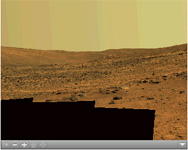
Click on the image for Spirit's 'Paige' Panorama of the Interior of 'Home Plate' (QTVR)On Feb. 19, 2006, the 758th Martian day of exploration of the red planet by NASA's Mars Exploration Rover Spirit, the rover acquired this panoramic view of the interior of "Home Plate," a circular topographic feature amid the "Columbia Hills." This view, called the "Paige" panorama, is from the top of Home Plate. It shows layered rocks exposed at the edge as well as dark rocks exhibiting both smooth and sponge-like "scoriaceous" textures. To the east from this vantage point, "McCool Hill" looms on the horizon. At the base of McCool Hill is a reddish outcrop called "Oberth," which Spirit may explore during the rapidly approaching Martian winter. "Von Braun" and "Goddard" hills are partially visible beyond the opposite rim of Home Plate.
The limited spatial coverage of this panorama is the result of steadily decreasing power available to the rover for science activities as the Martian winter arrives and the sun traces a lower path across the sky. The rover team anticipates that the north-facing slopes of McCool Hill should sufficiently tilt the rover's solar panels toward the sun to allow Spirit to survive the winter.
The view covers about 230 degrees of terrain around the rover. Spirit's panoramic camera (Pancam) took 72 separate images of this scene with four different Pancam filters. This is an approximately true-color rendering using the Pancam's 75-nanometer, 535-nanometer, and 432-nanometer filters. Image-to-image seams have been eliminated from the sky portion of the mosaic to better simulate the vista a person standing on Mars would see.

